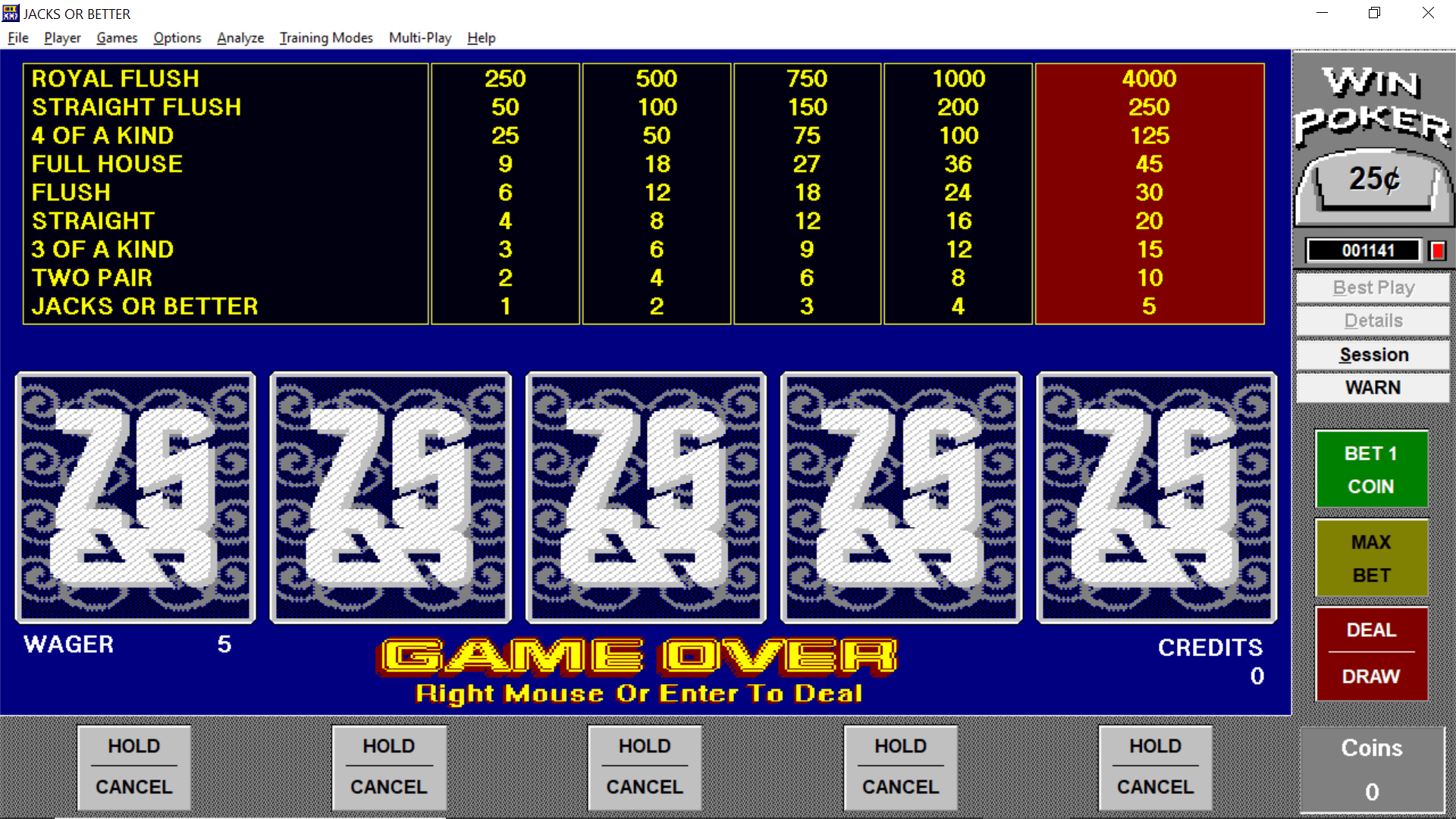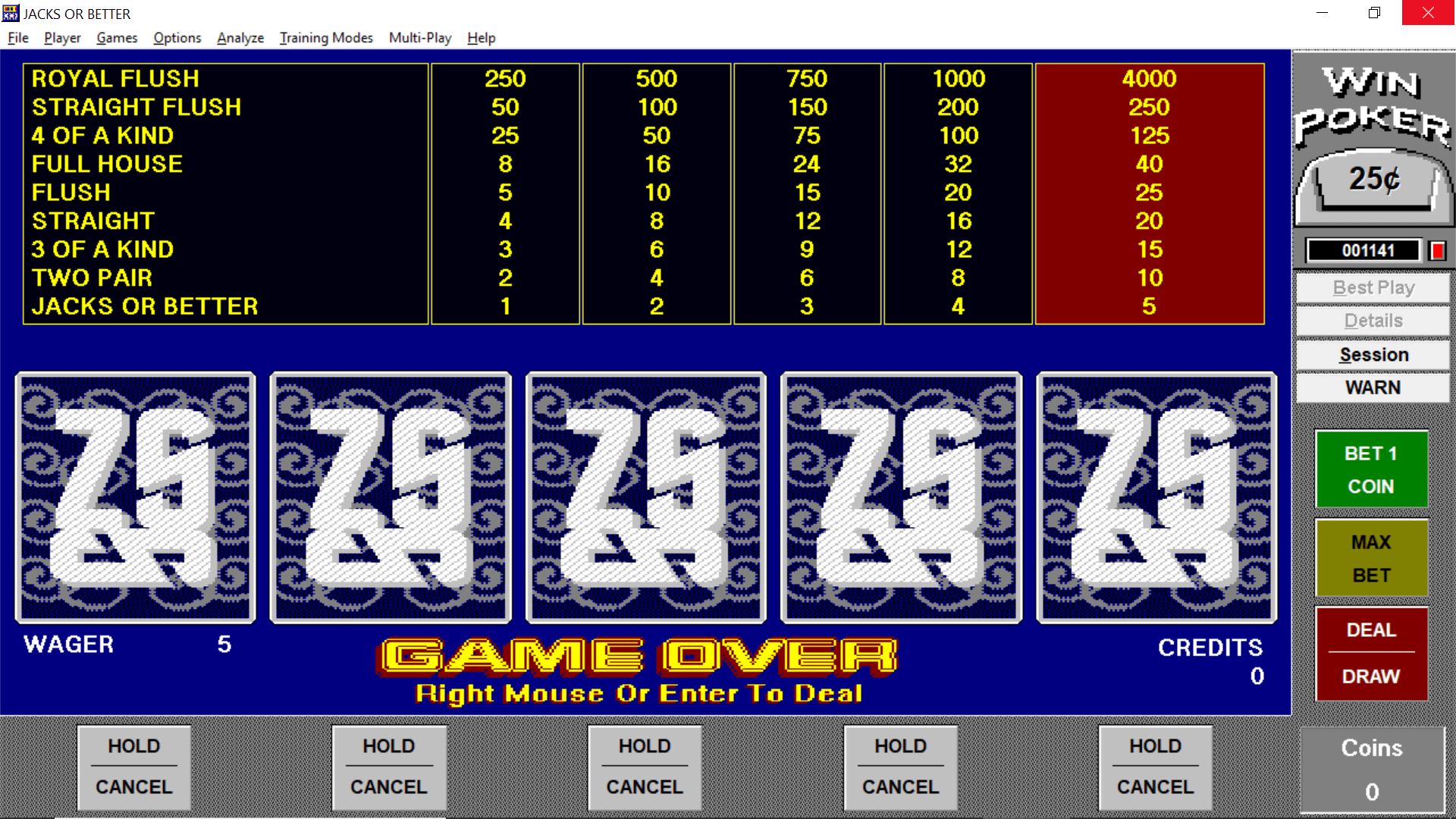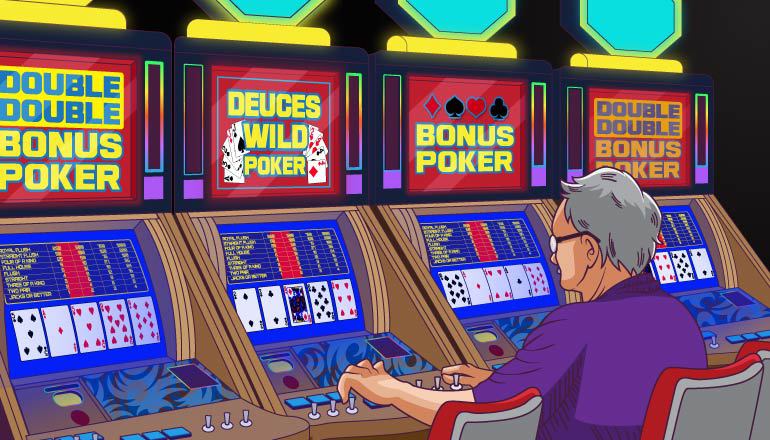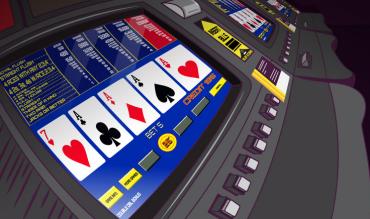It is no secret that returns from video poker games have been on the decline. Such is capitalism. Casino management wants to make the most profit possible from the gaming floor. Consider the three pay tables shown below. They are for Jacks or Better. They include the full-pay (sometimes called 9/6) as well as lesser paying schedules.
How Are Video Poker Pay Tables Labeled?
In most cases, the pay table that was initially released for a specific game had the highest return to the player. Over the years, as the popularity of video poker grew rapidly, casinos began changing the pay tables to increase their edge. While not always the case, when casino management lowers the return of a pay table, the two lines that are normally changed are those for the “Full House” and “Flush.”
The original Jacks or Better (originally called Draw Poker) pay table paid nine coins for each coin bet for a full house and six coins for each coin bet for a flush. This was considered the “full-pay” version of the game since later pay tables virtually always paid less. The short-cut way to refer to this pay table became 9/6 which indicated the pays for full house and flush.
Later pay tables for Jacks or Better no longer were 9/6. They were changed to 8/6, 9/5, 8/5, and even lower returns such as 7/5. The 8/6 pay table pays 8-for-1 for a full house and 6-for-1 for a flush. The 9/5 pay table pays 9-for-1 for a full house and 5-for-1 for a flush. In each case, whether it is 7/5, 8/5, 9/5, 8/6, or 9/6, the first number refers to the pay for a full house and the second number refers to the pay for a flush. Normally, no other pay lines are changed.
For each reduction of one coin for a full house or a flush, the return of that game is reduced by a little more than 1 percent – meaning a little more than a 1 percent increase in casino profit. These two pay lines have a big influence on the overall return. The details of the exact reduction in returns are shown below after the images.
What follows are three pay tables – all Jacks or Better – 9/6, 8/5, and 7/5.
JACKS OR BETTER FULL-PAY (9/6)

JACKS OR BETTER 8/5 VERSION

JACKS OR BETTER 7/5 VERSION

At one time, a few decades ago, the Jacks or Better 9/6 version (paying 9 for 1 for a full house and 6 for 1 for a flush) shown in the first image was common. As time passed, the inventory of 9/6 Jacks or Better video poker slowly gave way to the 8/5 version shown in the second image. Today, the 7/5 version of Jacks or Better video poker holds a substantial piece of the casino floor video poker footprint. Many of today’s casinos offer a 6/5 version on the main casino floor and offer the 8/5 version only in the high roller section of their casino.
Let’s look at the effects of reducing the pays for full house and flush by a single credit.
With perfect play (and over time), the 9/6 version returns 99.5 percent of the amount wagered by the player.
The 8/5 version returns just 97.3 percent. By reducing the pays for the full house and flush by one credit each (which doesn’t sound like a lot), the return is lowered by 2.2 percent. The house edge goes from a half a percent to 2.7 percent.
The 7/5 version of Jacks or Better video poker returns just 96.1 percent of the amount wagered on the game. Lowering the pay for a full house by one additional credit reduces the return of the game by an additional 1.2 percent. The house edge for the 7/5 version of Jacks or Better is 3.9 percent.
Keep in mind that these percentages are assuming the player plays a perfect game.
What is Perfect Play?
Perfect play means the player always saves for the highest expected return. Very few video poker players even know what the best plays are, much less are they able to play each and every hand perfectly. Each mistake puts a little bit more of the casino’s video poker pot.
And, even more disappointing, many casinos have even worse video poker pay tables. It is not uncommon to see games returning 95 percent, 94 percent or even less.
Casinos generally have approximately the same return percentages on the same type and denomination of video poker game throughout the casino. If a 25 cent Jacks or Better game on one machine returns 97 percent, usually other 25 cent Jacks or Better games in the same casino will have the same return percentage. The return percentages will generally vary by denomination with lower denominations generally have lower return percentages and higher denomination games having high return percentages.
Even when a casino has consistent return percentages for the same type and denomination of video poker game, each distinct game type within a denomination can have a different return percentage.
A-25 cent single play Jacks or Better game can have a different return percentage than a three-play game which can be different than a five-play game. Each different number of plays could have a different return percentage.
Progressive games almost always have a lower return percentage when the progressive jackpot is at the starting (or reset) value. As the progressive jackpot builds, the return percentage increases. If the progressive jackpot gets high enough, the return percentage can meet or exceed that of a same denomination single play game.
A Look at the House Edges
Let's look at what return (and house edge) percentages actually mean to video poker players.
With perfect play, full-pay (9/6) Jacks or Better games return 99.5 percent of the amount played through the game. For every 100 dollars played through, the game costs the player only 50 cents. How much play constitutes $100? 80 hands at $1.25 a hand on a 25-cent game and 20 hands at 5 dollars per hand on a dollar game amounts to 100 dollars played. Considering the average video poker player completes roughly 500 hands per hour, the difference can really add up.

Compare that to the 8/5 Jacks or Better game which returns 97.3 percent (2.7 percent house edge). For every 80 hands on a 25-cent game and every 20 hands on a dollar game, the player will lose $2.70 on average.
What about the 7/5 Jacks or Better game returning 96.1 percent (3.9 percent house edge) with perfect play? For every 100 dollars played, the player will lose $3.90. That amounts to 19.5 cents on each and every hand for the dollar player.
In many casinos it is worse. A game that returns 95 percent costs the player five dollars for every 100 dollars wagered – that amounts to 25 cents per hand for a dollar game.
Keep in mind that this is the average loss for a player who plays the game perfectly – and few do that. Exacerbating the situation is the fact that it is very common for video poker players to play 500, 600, 800, and even 1,000 hands per hour. At 500 hands per hour, a player playing perfectly on a dollar full-pay Jacks or Better game returning 99.5 percent will lose $12.50 per hour of play on average.
At the same rate a player on a 7/5 Jacks or Better game will lose will lose $97.50 per hour. That is a huge difference.
Are There Full-Pay (9/6) Jacks or Better Machines in Las Vegas?
At one time full-pay (9/6) Jacks or Better machines could be found in nearly every Las Vegas casino. The landscape slowly changed. It is increasingly difficult to find these sought-after games in Vegas today.
How can a video poker player locate these full-pay Jacks or Better games today? Try doing a search of the Internet for “9/6 Jacks or Better Vegas”. You will get some valid results, but this could be hit or miss.
The website "vpfree2" has video poker information for casinos throughout the U.S. It shows video poker inventory for each casino in most gambling venues in the country. The information includes game, pay table, and denomination. It is certainly worth a look.
Full-pay (9/6) Jacks or Better Playing Strategy
If players are to get the most out of their play, they must play the proper strategy. This strategy changes based on the game and pay table. If players are fortunate enough to find a full-pay (9/6) Jacks or Better game, they should play the proper strategy.
Strategies for several games are readily available by searching the Internet. If playing full-pay Jacks or Better, search for “jacks or better strategy”. Several options will appear. Make sure that they are for the full-pay (9/6) Jacks or Better game as other varieties of video poker also have 9/6 pay tables.
Summary
Full pay Jacks or Better video poker is becoming more and more difficult to find. In today’s casinos, the 8/5 version is usually the highest paying Jacks or Better game that can be found – many times, even at a $5 per credit denomination in the high stakes room.
Spotting the casino an additional house edge of over two percent makes playing 8/5 Jacks or Better a bad idea (in my opinion). A player can make a lot of errors on a 9/6 game and still have the house edge be much lower than that of the 8/5 game. What should a player do?
Many (if not most) casinos that feature 8/5 Jacks or Better as their highest paying Jacks or Better game, also have 8/5 Bonus Poker which has a house edge of just 0.9 percent. The video poker strategy is also relatively simple. It is similar to Jacks or Better strategy so the learning curve is fairly low. Look for these games.
If there are no 8/5 bonus poker games available, check for other video poker variations such as Deuces Wild. With a little searching, most casinos have some sort of video poker game that has a low house edge of about one percent or less.
The house edge is the primary driver for successful video poker play - meaning returning home with the most money. It is next to impossible to have winning sessions when playing games with more than a two percent house edge.
However – and this is a big however – if you have the bankroll to play higher house edge games and don’t get upset with losses, play whatever game you find interesting. It is your money to enjoy spending however you please. Just make sure your bankroll is specifically reserved for casino play and not part of your normal monthly budget.
As long as the player knows what the house edge is and understands what that means to their bankroll, they are going into the casino with their eyes open. They must make sure, however, that when they enter the casino, they have an adequate bankroll and the discipline to not play beyond it.
It is their money. If they are aware of the cost of their entertainment and can afford the loss, it is their money and their choice.
Play to have fun – however fun is defined.


